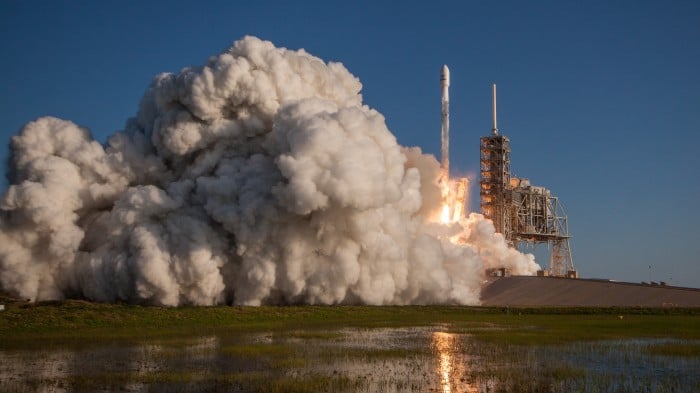SpaceX Has a Reusable Rocket, and Now the Race Is on to Perfect Them

Recycling rockets is a promising new idea, and SpaceX is clearly leading the way. But with only one demonstration to show that it works so far, there’s still plenty of scope for better techniques to steal the company's thunder.
Just last week, SpaceX successfully launched a refurbished rocket, putting a satellite into orbit and then landing the entire first stage again for good measure. Its long-term goal: to turn around rockets within 24 hours, so that they’re launched, landed, and relaunched again in a single day.
While it’s an impressive feat, what we didn’t know then was how cost-effective the approach is. It’s perhaps not surprising, then, that the technology has proven to be a hot topic this week at the 33rd Space Symposium in Colorado Springs, where the great and good of the space industry have gathered to share reports of their progress.
Tory Bruno, CEO of United Launch Alliance—the Lockheed Martin-Boeing collaboration that provides launch capabilities for the Department of Defense and NASA, and hasn’t yet tested rocket reuse—seems unsure that SpaceX’s approach is definitely the right one. According to the Financial Times (paywall), he explained at the event that the approach is “not necessarily a giant game-changing alteration to the cost basis.” Then, speaking to Florida Today, he said that “the jury’s still out on what is the best way” to recycle rockets.
SpaceX would beg to differ. According to its president, Gwynne Shotwell, the cost of refurbishing and reusing a previously flown booster using its approach was “substantially less than half” as much as the cost of using a new one. And things should improve further: she added that the company had to do “way more on this one than we’re doing on future ones."
Elon Musk was quick to point out that those savings won’t be passed on to customers looking to use the services of SpaceX. Pegging investment into reusable rockets so far at a cool $1 billion, he said that pricing discounts would be adjusted so that the company was able “to repay the massive development costs.”
Musk explained after last week’s successful reuse that he believed launch companies that weren’t offering reusable rockets would be left dead in the water. He’s likely to be right—but that doesn’t mean that his company’s approach is the right one.
For its part, United Launch Alliance is currently looking into ways to make use of components more than once. But unlike SpaceX, it plans to recover the booster engines attached to either side of its Vulcan rocket, rather than the entire first stage. It claims that approach will be more cost-effective. Meanwhile Blue Origin, the space company owned by Amazon CEO Jeff Bezos, is also trying its hand at recycling rockets, though its approach is similar to that of SpaceX.
This kind of competitive innovation, seemingly played out on the scale of months, is somewhat of a departure for the space industry, which has tended to move more slowly in the past. And while SpaceX has stolen an early lead, that doesn’t guarantee victory. “It’s not obvious how it will turn out, and that’s why people are trying different things,” said Bruno, again speaking to Florida Today. “We’re going to find out who’s right, and that’s kind of the beauty of competition.”
One thing that is certain, though, is that the commercial space race has firmly arrived—along with much of the Silicon Valley-style jostling and swagger that some of its insurgents know so very well.
(Read more: Florida Today, Space News, Financial Times, “SpaceX Has Reused Its First Rocket,” “Tech CEO Space Race Intensifies,” “Reusable Rockets”)
Keep Reading
Most Popular
Large language models can do jaw-dropping things. But nobody knows exactly why.
And that's a problem. Figuring it out is one of the biggest scientific puzzles of our time and a crucial step towards controlling more powerful future models.
The problem with plug-in hybrids? Their drivers.
Plug-in hybrids are often sold as a transition to EVs, but new data from Europe shows we’re still underestimating the emissions they produce.
Google DeepMind’s new generative model makes Super Mario–like games from scratch
Genie learns how to control games by watching hours and hours of video. It could help train next-gen robots too.
How scientists traced a mysterious covid case back to six toilets
When wastewater surveillance turns into a hunt for a single infected individual, the ethics get tricky.
Stay connected
Get the latest updates from
MIT Technology Review
Discover special offers, top stories, upcoming events, and more.